new posts in all blogs
Viewing: Blog Posts Tagged with: poetry and cake month, Most Recent at Top [Help]
Results 1 - 13 of 13
How to use this Page
You are viewing the most recent posts tagged with the words: poetry and cake month in the JacketFlap blog reader. What is a tag? Think of a tag as a keyword or category label. Tags can both help you find posts on JacketFlap.com as well as provide an easy way for you to "remember" and classify posts for later recall. Try adding a tag yourself by clicking "Add a tag" below a post's header. Scroll down through the list of Recent Posts in the left column and click on a post title that sounds interesting. You can view all posts from a specific blog by clicking the Blog name in the right column, or you can click a 'More Posts from this Blog' link in any individual post.
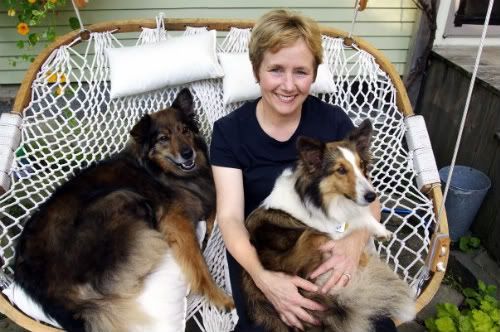
Melissa with Rufus and Nellie.
Friends, I’m tickled pink and over the moon, because our very special guest at alphabet soup today is 2009 Caldecott Honor Medal winner, Melissa Sweet!
I can’t think of a better way to top off National Poetry Month, than with the illustrator who so brilliantly rendered the story of how Willie Williams, a doctor from Rutherford, New Jersey, became one of America’s most influential twentieth century poets.

If you’ve seen Melissa’s masterful work in A River of Words: The Story of William Carlos Williams (beautifully written by Jen Bryant), then you know the award was supremely well deserved. Her mixed media collages embody the very soul and spirit of the poet, who “walked through the high grasses and along the soft dirt paths . . . stretched out beside the Passaic River . . . watched everything,” took notes “about things he’d heard, seen, or done . . . looked at the words . . . and shaped them into poems.”
I learned from Melissa's website bio that these words by poet Mary Oliver are posted above her drafting table: “To pay attention, this is our endless and proper work.” Melissa says, “That’s good, because I often find myself taking walks, gardening, biking, but I’m taking it all in and it somehow shows up in my books.” Like Williams, Melissa is a keen observer, chronicler, and collector. She is constantly on the lookout for all manner of found objects and ephemera to use in creating her exuberant, charming collages. Quite amazing is the childlike spirit that always shines through in very sophisticated works of art. Her illos are endlessly engaging, radiantly fresh and winsome, like cherished one-of-a-kind objects that are handmade and "heart-made.”
Melissa has received countless awards and accolades for many of the 70+ books she’s illustrated for such luminaries as James Howe, Jane Yolen, Jacqueline Davies, Joanne Ryder, and Jacqueline Briggs Martin. She’s also published two self-illustrated titles, Tupelo Rides the Rails (2008), which celebrates her love for dogs, and the one book that makes me swoon every time I think about it, Carmine: A Little More Red (2005), which is my all-time favorite alphabet-themed book (complete with soup recipe)! Nobody draws letters like she does; they virtually sing with personality.

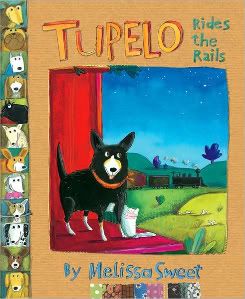
Today Melissa is chatting with us all the way from her home in Rockport, Maine, where she lives with her husband, stepdaughter, three cats, and beloved dogs, Rufus and Nellie. We focused on A River of Words, which, in addition to the Caldecott Honor, received a ton of other accolades, including 2008 Cybils finalist, 2008 New York Times Best Illustrated Book, Junior Library Guild Selection, and 2009 Lupine Picture Book Award.
Congratulations once again on winning a Caldecott Honor Medal for A River of Words! Please tell us all about THE CALL. Did you do anything special to celebrate?
Thank you! That morning I got set up in the studio as usual, but it was a gorgeous cold morning so I took my dogs for a walk. THE CALL came in via cell phone to my machine and I tried to call them back but it went to message, so I quickly called my husband, then tried them again, only to realize in my haste I had written the number wrong. Suffice it to say it was a comedy of errors and we spoke much later. I feel like I’ve celebrated at every opportunity, but the party in Portland in March was the best.
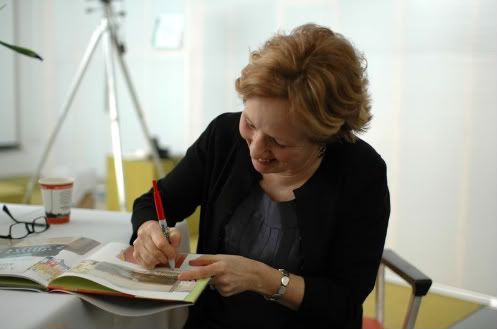
Melissa signing books at her Caldecott party in Portland, Maine, March 2009.
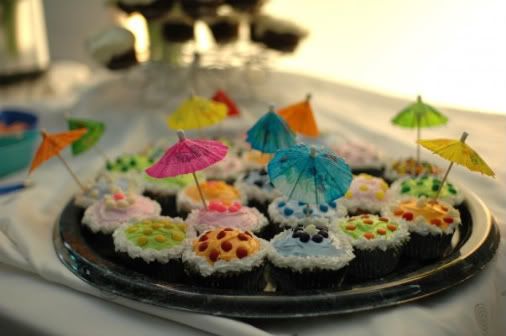
Of course there were cupcakes.
How did this project come to you, and what made you say yes to it? Did you know right away that you wanted to illustrate Jen Bryant’s text?
Gayle Brown, the art director at Eerdmans Books for Young Readers, had seen another nonfiction book I did, The Boy Who Drew Birds by Jacqueline Davies. I said “yes" pretty much right away. Though I didn’t know a lot about WCW, I wanted to do this book -- it was a big challenge. I really had no idea how I would render it at that time.
In your Illustrator’s Note, you talk about going to Rutherford and Paterson, New Jersey, to research, take pictures, and sketch. What details about Williams’ life intrigued, excited and/or surprised you most during this discovery phase?
The few poems of his I had heard were the ones many people know: "The Red Wheelbarrow," "This is Just to Say," "The Great Figure." When I went to Paterson, I thought about him making house calls there as a doctor, and saw the house where he lived and practiced in Rutherford. Somehow, going there, (going anywhere to do research), makes it more real. These were the streets he drove down, here’s the Passaic River, the library, etc. The research for a non-fiction book can be done from home, but I find I get more in touch with the person just by being where they were. Pictures can’t do that.
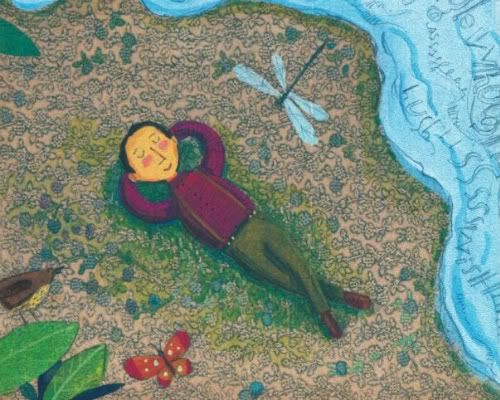
"The river's music both excited and soothed Willie. Sometimes, as he listened to its perfect tune, he fell asleep." (A River of Words, 2008).
When I was working on The Boy Who Drew Birds, I went to Mill Grove, Pennsylvania, where the book takes place, and visited the house where Audubon lived. When I saw the attic room that was his bedroom and studio, I felt like I had the whole book. It gives me a sort of impression even if I don't actually use the material I've gathered.
You also said that this book was a “true gift.” How did working on it stretch you as an artist? Was it the most challenging project you’ve ever done? How long did it take you to complete it?
It took one month to do the final art. When I finally decided how to do it, I just went for it. I didn’t know if I could pull it off. Gayle Brown loved a sample piece and was so encouraging. It was a wonderful project where the stars aligned. I don’t know if I’ve ever felt the kind of freedom I had from start to finish. It was one of the easiest projects on one hand, and the magnitude of his poems was a privilege to work with.
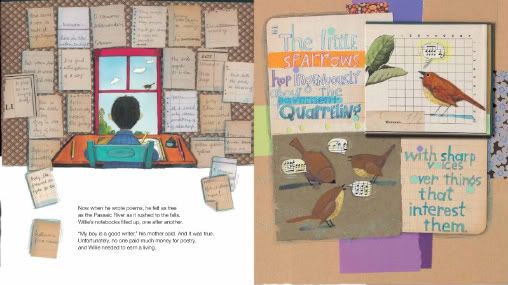
Spread featuring "Pastoral," by William Carlos Williams.
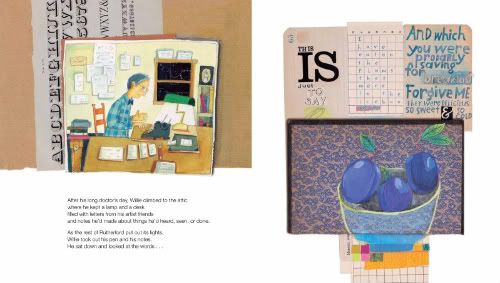
Spread featuring "This is Just to Say."
Do you have a favorite illustration from the book, a favorite poem?
The last image from the book, of WCW writing in his attic room. The poem is "11/1" (excerpt from The Descent of Winter), and he mentions the Pleiades. I spelled Pleiades wrong in the art a couple of times, and kept going over it to get it right. I could practically smell the night after reading that poem.
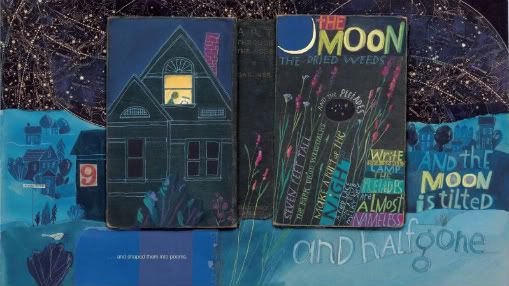
Melissa's favorite illo from the book.
Using any one of the illustrations from the book as an example, briefly explain how you created it. What was your favorite part of the process?
I started by gathering images, typography, book covers, getting a pile of stuff nearby to work with. We can talk about "The Great Figure," (the one in reds with the big FIVE).
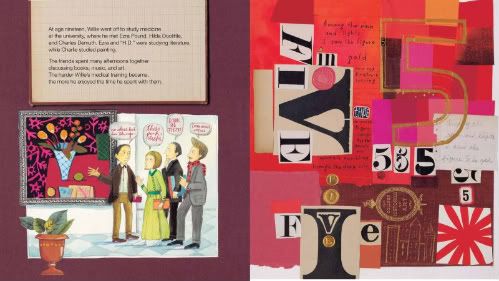
Spread featuring "The Great Figure."
I start with the background, add some paint, then begin to place the type and maybe do an overlay of the poem to get a sense of how much room it will take. I push the pieces around; at a certain point it becomes a design problem. How is this working as a piece of art? Is the emphasis where I want it? Then, if anything I’ve added feels wrong, out it goes. It’s intuitive. You know when it’s finished because nothing else needs to be done to it.
What do you think your love for collage says about you as an artist and person? What is the most unusual found object you’ve used in your work?
I’m not certain what it means about me, but collage has always made me weak in the knees. There’s a lot of chance and trust involved -- trust that it will work out!
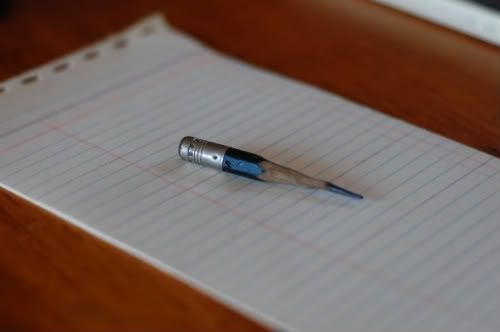
The famous pencil.
As far as the most unusual object, I have some pretty crazy stuff out here. This is it: a pencil about 2 inches long that I found in a button box. Someone had sharpened it to within an inch of its life, and the point is really long. That pencil was really used. I keep thinking I should frame it. My stepdaughter picked it up one day and I went into orbit: don’t touch that pencil! like it was the most valuable thing on the planet. The poor kid, but she’s used to me. I’m worried the point will break.
Overall, how would you describe your style for illustrating children’s books? How long did it take you to fully realize it, and what’s your preferred medium?
It took years, and each book is so different, my style really tries to reflect what the book is about. I feel like after 20+ years I’m just getting going. If I could only have one medium, it would be watercolors.
Who or what inspires you?
That’s a long list. People’s sketchbooks and studios for starters.
I absolutely love Carmine: A Little More Red, the first book you both wrote and illustrated, for its alphabetical twist and hand-drawn letters. How did you get the idea to use granny’s alphabet soup in your story? Do you often play with alphabet pasta?
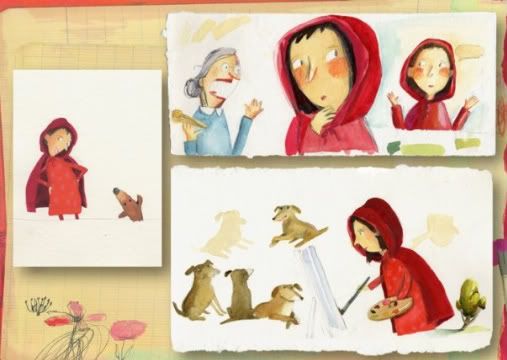
Carmine character studies.
That came out of the idea of making the book an abecedarian. When I thought about the granny’s character, I knew I didn’t want the wolf to eat her and that Carmine would go to her house for some great meal. I still associate my grandmother’s home with food. The alphabet soup came out of that -- the perfect food for an alphabet book. Then the pasta letters help hammer it home.
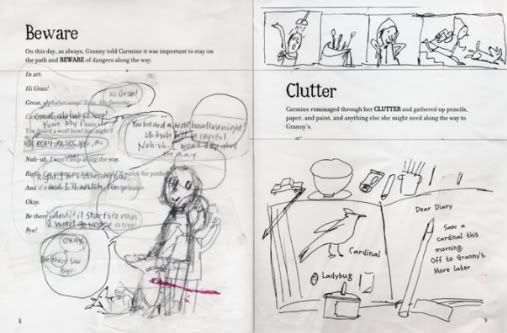
Carmine sketches.

Carmine finished art.
What can you tell us about your new book, The Sleepy Little Alphabet (written by Judy Sierra), which will be out in June?
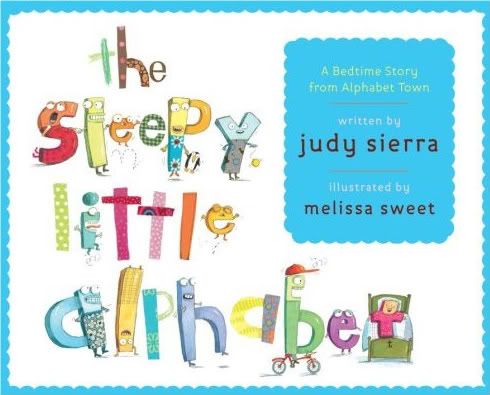
I LOVE this book. Judy wrote a wonderful, funny story about the alphabet letters (lower case) and their parents (upper case), who live in Alphabet Town. They won’t go to bed, and N is naughty, M is mopey, O and P upset the potty . . . it was a lot of fun to illustrate and make the letters into these little rascal characters.
What are you working on now?
I’m writing a biography and have a couple of other picture books for this year.
QUICK BITES
Favorite letter of the alphabet.
"N." To be honest, I love all the letters for different reasons, but N can be upside down and still look good. It's architecturally strong and makes for superb swirls. Plus, in The Sleepy Alphabet, N was "naughty" and gave me room for a bit of a sub-story. It's always helpful to have a naughty character to play off of. N endeared itself to me.
Favorite childhood food-related memory.
The first time I ever had S'mores.
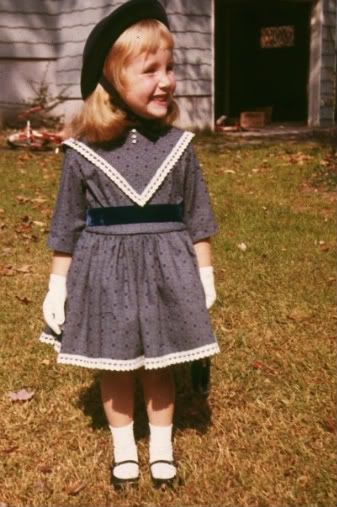
Melissa at about age 4 (awesome gloves)!
Food that inspires your best work.
Tea, black or green.
Authors and/or artists who've had the most influence on your work.
David Hockney.
Something surprising about yourself.
I cannot sing, not one wit, not one note, it's unbearable to hear me try.
You've illustrated several cookbooks, as well as the wonderful, My A-Z Recipe Box. Please share a favorite recipe with us.

This is adapted from the book, Cheese: Quick and Easy Recipes for Elegant Entertaining by Lou Seibert Pappas:
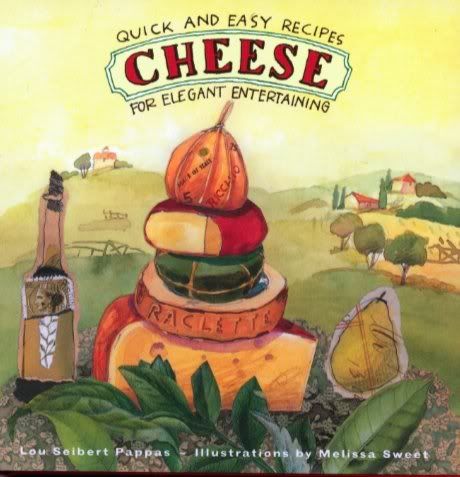
QUICK QUESADILLAS
(6) 8" flour tortillas
2 cups monterey jack cheese, shredded
1 mango or papaya, peeled and cut into small pieces
Heat a large skillet and lay down a tortilla, lightly browning one side. Flip it, then sprinkle some of the cheese and some sliced mango. Top with another tortilla and cook until cheese is melting, then flip to brown the other side. Transfer to a cutting board and cut into wedges. Serve while hot.
Make a salad, and as Carmine would say: "Voila!"
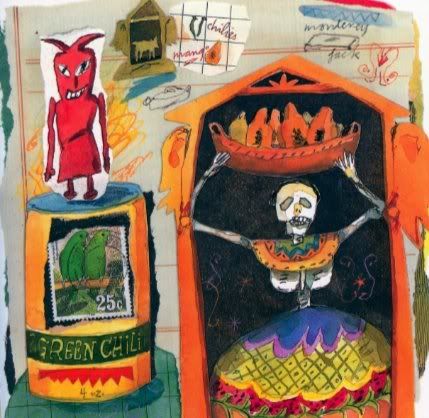
Spread from the cheese cookbook.
MORE MORE MORE:
Visit Melissa's official website and new blog!
Read more about the book at Jen Bryant's website, including a full list of all the awards AROW has received thus far.
Last September, Mary Lee at A Year of Reading interviewed Melissa, and they discussed both A River of Words and Tupelo Rides the Rails. At that time, Mary Lee voiced her strong support for A River of Words, saying she wanted to nominate it for the Caldecott!
For a look at Melissa's home and studio in Rockport, Maine, check out this awesome blog post by Alison at Shelf Talker. At the time of Alison's visit, Melissa was working on A River of Words, so there are some cool photos of the work in progress.
Tracie Vaughn Zimmer has created some great teacher guides for Tupelo Rides the Rails, A River of Words, and Carmine: A Little More Red.
Have you been to My Dog is a Bonehead yet? This website is devoted to Tupelo Rides the Rails, and will have you yipping with joy. Did you know that a portion of the proceeds from the sale of Tupelo will go to support shelter dogs and rescue causes nationwide? And, for every dog who becomes a member of the pack (i.e., official Bonehead), Melissa will make a shelter donation! Go over right now and sniff out the site!
SWEETER THAN SWEET BOOK GIVEAWAY:
Just leave a comment at this post by midnight (EST), Friday,
May 8, 2009, for a chance to win a signed copy of either A River of Words, or Cheese: Quick and Easy Recipes for Elegant Entertaining. First name drawn will win Cheese, second name drawn will win River. Mention this giveaway on your blog (let me know here), and you'll be entered twice.
If you prefer, you may enter the giveaway by emailing me: readermail (at) jamakimrattigan (dot com). Just put "Sweet Contest" in the subject line!
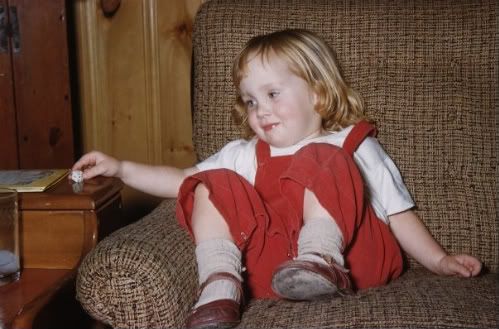
Melissa, a little more red, considers an object for a future collage.
*Spreads from A River of Words posted by permission, text copyright © 2008 Jen Bryant, illustrations © 2008 Melissa Sweet, published by Eerdmans Books for Young Readers. Spreads from Carmine: A Little More Red (Houghton Mifflin, 2005) and Cheese (Chronicle, 1996), and all personal photos posted by permission of illustrator, copyright © 2009 Melissa Sweet. All rights reserved.
This is one delicious way to promote a new book!
"A poem is a naked person. Some people say that I am a poet." ~ Bob Dylan
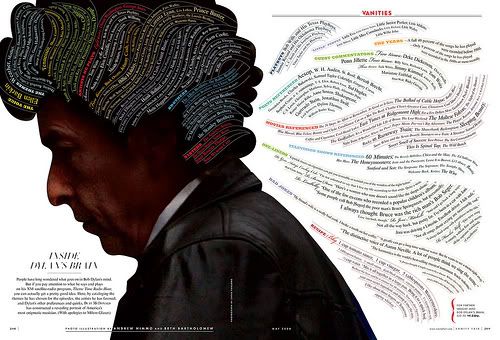
So, I simply can't celebrate National Poetry Month without mentioning my man.
Found this very cool piece in Vanity Fair by Duff McDonald, called "Inside Dylan's Brain" (click through to lopez2k95's photostream, "all sizes," to see full size version of graphic).
By cataloguing some of Dylan's themes, musical preferences, quips, quotes and other bits and pieces from his Theme Time Radio Hour show on XM Satellite radio, McDonald has given us a glimpse into the mind of the Pulitzer Prize winning song and dance man.
I like that Dylan's given advice on "How to Walk Like a Runway Model," and "How to Give Yourself Dreadlocks." He's played George Jones more than any other artist; he's mentioned Shakespeare, Poe, Joyce, Cummings, Yeats, Plath. He's pontificated on Women's Names, Shoes, Thanksgiving Leftovers and Spring Cleaning. And you gotta love a man who makes his own barbecue sauce and meatballs, and shares his recipe for Figgy Pudding. Fascinating stuff!
Read the entire list at Vanity Fair.
I also listened to "Last Thoughts on Woody Guthrie" again, and found it very moving, still relevant in these turbulent, uncertain times. This poem is the only one Dylan has ever read in public (April 12, 1963 at New York Town Hall); it's a tribute to the man who probably had the strongest influence on his music, and speaks to the crucial role the poet/songwriter/artist has in society. Eric Clapton said this about Dylan:
He's a poet. Basically he's a poet. He does not trust his voice. He doesn't trust his guitar playing. He doesn't think he's good at anything, except writing—and even then he has self-doubts. Have you heard that thing he wrote about Woody Guthrie? That to me is the sum of his life's work so far. Whatever happens, that is it. That sums it up.
I hope you'll take a few minutes to listen to it, really listen to it. Don't we all have this feeling, of wanting something or someone to believe in, looking for hope somewhere, anywhere? When we've come to the end of our rope, what can we hold on to?
You can find the poem in its entirety here.
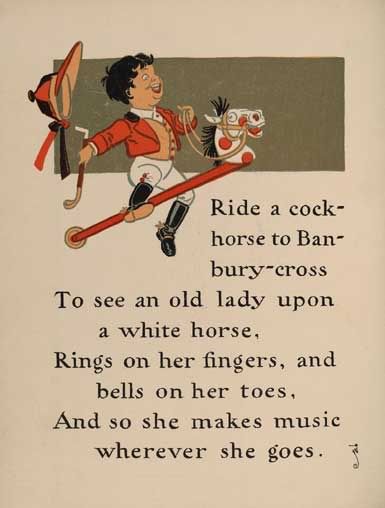
From Denslow's Mother Goose, 1902.
While reading up on Medieval/Elizabethan food for Shakespeare's birthday yesterday, some very fetching banbury cakes insisted that I pay attention to them.
Naturally, I was reminded of the English nursery rhyme, and the time Len and I traveled to Banbury for a taste of those famous cakes. Food, you see, is always the great motivator.
First, a little about the rhyme, which in the version I'm most familiar with, cites a "fine lady," rather than an old one. It's widely held that she's Queen Elizabeth I, who traveled to Banbury to visit a stone cross that had just been erected. The town is located at the top of a steep hill, so a large white stallion was often used to help carriages up.
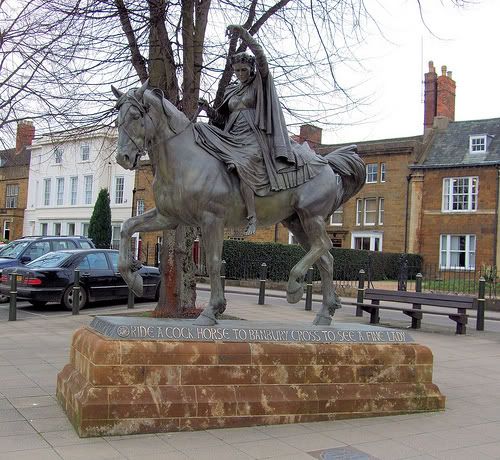
photo of "Fine Lady" by Jim Linwood.
Seems a wheel broke on the Queen's carriage, so she was obliged to mount the horse and ride to the cross. The town had decorated the horse with lovely ribbons and bells, and minstrels accompanied her ("she shall have music wherever she goes"). Unfortunately, the original Banbury Cross was destroyed by Puritans in 1602, but another replaced it in 1859:

This was built to commemorate the marriage of Queen Victoria's eldest daughter to Prince Frederick of Prussia (photo by Running in Suffolk).
*rubs hands together and licks lips*
Now, for the cakes. They date back to the 13th century, when returning Crusaders brought back fruit and spices from the Near East. The Elizabethans were sugar crazy, and the Queen's legendary sweet tooth turned her set of chompers black. During Shakespeare's time, Banbury was widely known for its cheese and cakes. It is believed that poet and dramatist, Ben Jonson, attended the Banbury Fair (famous in England for centuries), and while there, visited the bakehouse, and chatted with the owner, Richard Busby. Not too long after, Jonson wrote his famous comedy, "Bartholomew Fair," where the cakes are mentioned by the character Quarlous:
I remember that, too, out of a scruple he took that, in spiced conscience, those cakes he made were served to bridals, may-poles, morrises and such profane feasts and meetings.
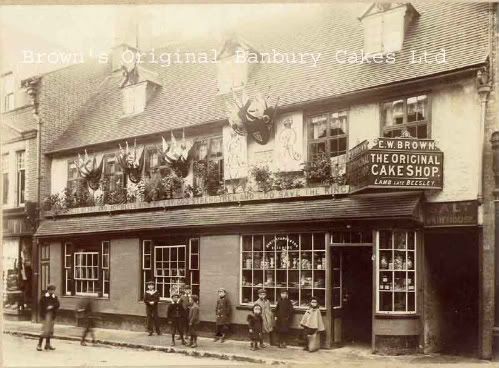
Original Cake Shop, 1902.
There is evidence of a pre-existing bakehouse dating back to the 13th century in the same location where the present day "Original Cake Shop," (circa 1550), now stands. Ownership changed hands through the years, but the family of E.W. Brown has been associated with the "Original Banbury Cake" since 1868. Apparently the cakes are still baked by hand, according to the family's secret, historic recipe, under the supervision of Philip Brown.
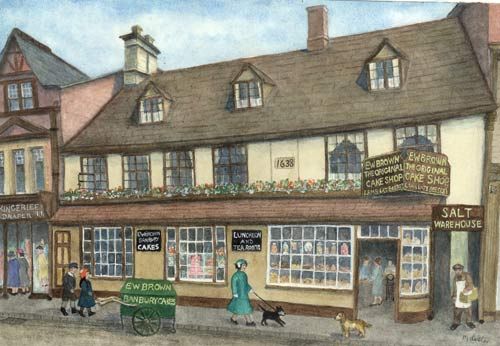
from "Memories of Banbury" by Marjory Lester.
Just what are these famous cakes like? They're puff pastry, usually oval shaped, filled with currants, other fruits, flavorings, spices, and sprinkled with cane sugar. I vaguely remember eating mine while standing on some sort of foot bridge. It was so long ago that I thought maybe I had imagined it. I asked Len the other night (he of the exacting memory) -- and sure enough, he remembers buying them warm from the bake shop and biting into the currant filling.

Brown's Original Banbury Cakes
Well, now, since it was so long ago and all this talk has me craving these little cakes (and because Mr. Shakespeare would have approved), I'm going to order some from Mr. Brown and try them again. The Original Cake Shop apparently ships them worldwide, as they have since the 18th century. Once again, I'll keep you posted!
Meanwhile, here's another poetic morsel to tide you over:
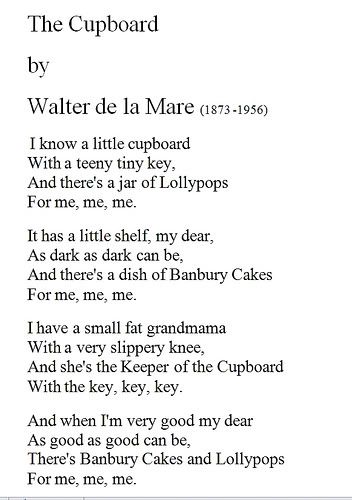
~ poem image from The Ancient Brit's photostream.
Lisa Chellman has trays of freshly baked poems in her cupboard today at Under the Covers. Stop in and sample as many as you like!
Several juicy morsels for the road:
Elizabethans considered sugar an aphrodisiac. A nobleman's meal always ended with a sweet course, called "The Banquet." It was designed to "moveth pleasure and lust of the body."
Sweets were often served on plates, called "roundels" or "banqueting dishes," which had an image or poem on them. Often these poems contained sexual innuendos and double entendres.
During Shakespeare's time, sonnets were all the rage. Poems were sometimes baked into walnut-sized pastries -- sort of like modern day fortune cookies.
*fans self*
Here's a recipe for banbury cakes (sshhh! don't tell Mr. Brown).
ONE MORE THING:
A very special Happy Birthday to Sara Lewis Holmes, Poetry Princess and novelist extraordinaire! As I said before, April is a good month for poetry -- Wordsworth, Shakespeare, Walter de la Mare, and Lee Bennett Hopkins were all born in April, along with three Poetry Princesses: Sara, Kelly Fineman and Liz Scanlon!
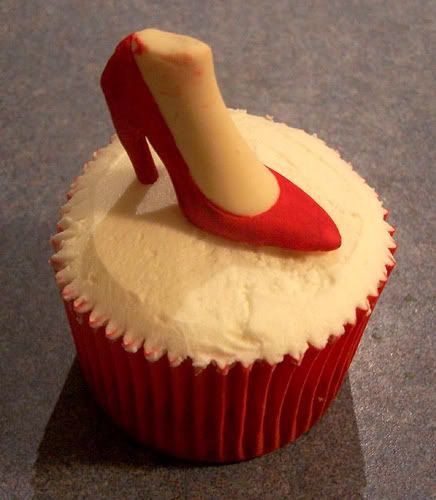
"A Shoe Sonnet for Sara" (cake of choice for runway writers).
photo by Sandra socake.
"Ride a cock horse to Banbury Cross,
To see what Tommy will buy.
A little white loaf and a little white cake,
And a tupenny apple pie."
"Dost thou think, because thou art virtuous, there shall be no more cakes and ale?" ~ Shakespeare, Twelfth Night.

Chandos portrait of Shakespeare, not yet authenticated.
Huzzah, I say, Huzzah!
And, bullyrook, scullion, rampallian, fustilarian! Let me tickle your catastrophe, o trencher-friends!
Lords, Ladies, Cousins and Curs: don your finest cauls, corsets, breeches and brocade! Only your finest jeweled or flowered ruffs will do. If thou hast need for a codpiece, joyfully tie a big one
on -- for today is Will Shakespeare's 445th birthday!
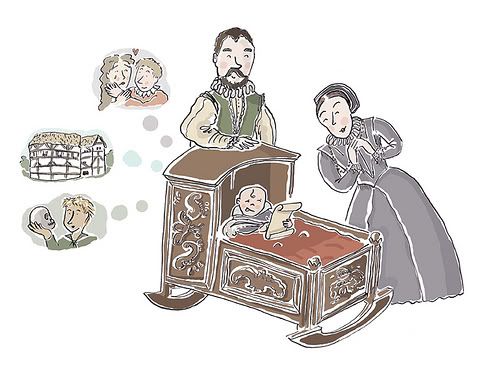
Ay, our most beloved red-haired poet, actor, and dramatist from Stratford-upon-Avon, who gave us 38 plays, 154 sonnets, and several other poems besides, is still the brightest star amongst all the luminaries who ever dared to tarry with the English language. His comedies, tragedies, and histories are still the most widely performed on the planet, and even after centuries of scholarship, speculation, and debate -- some details of his life, as well as doubt over his authorship, continue to mystify and enthrall enthusiasts and detractors alike.

Franco Zefferelli's "Romeo and Juliet" (1968).
photo from EmMe09's photostream.
I must admit I didn't truly "get" Shakespeare until I saw the Franco Zefferelli version of "Romeo and Juliet" in high school. I remember swooning over Leonard Whiting, and thinking Olivia Hussey the most beautiful woman ever. For the first time, I really listened to Shakespeare as these actors delivered their lines, and realized how beautiful, varied, complicated, precise, multi-faceted, and glorious the English language really was. For months afterwards, I listened to my R&J record and recited some of the most memorable speeches, imagining myself in "fair Verona, where we lay our scene."
In college, I was fortunate enough to make the requisite "English major pilgrimmage" to Stratford-upon-Avon one summer, to see the Bard's first digs for myself. I remember it to be dark, rustic, and well suited to short people. I knew that Shakespeare married an older woman, Anne Hathaway, when he was just 18, and she, 26. I loved visiting her cottage, and purchasing a mini copy of Shakespeare's sonnets at the gift shop. Several years later, I would return to England, meet and marry Len, and celebrate with an Elizabethan banquet.
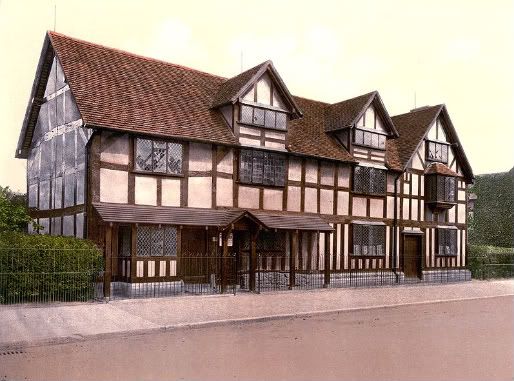
Shakespeare Birthplace, Stratford-upon-Avon.
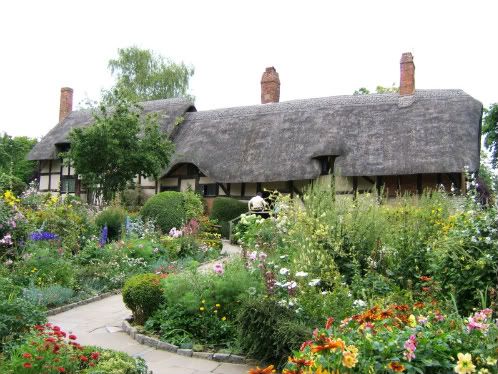
Anne Hathaway's Cottage (photo by SnowmanRadio).
These days, I am still trying to process the impact Shakespeare has had on modern English. They say the average person has a working vocabulary of around 10,000 words, a good novelist, probably around 15,000. Shakespeare's personal arsenal contained approximately 30,000 words; he used between 17 - 23,000 different words in his plays, and is responsible for introducing and/or inventing at least 1700 words. Some of these are quite surprising, since we use them all the time without knowing their source: puke, lonely, critic, exposure, amazement, bump. Many common phrases, such as, "sweets to the sweet," "lean and hungry look," "break the ice," " heart on your sleeve," "live long day," and, "one fell swoop," were also coined by the Bard.
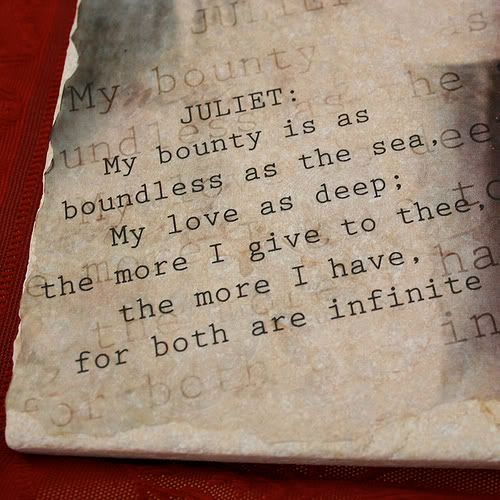
photo by Karmel Design.
In evaluating his genius, we need to consider that Shakespeare was truly a product of his age. During the reign of Elizabeth I, English was just coming into its own as a respected, significant literary language, replacing Latin as the language of serious intellectual and artistic activity in England.
Rules of grammar and spelling had not yet been fully formalized, so Shakespeare had free reign to experiment, bend and shape words, and play with syntax and vocabulary to suit his style, thereby giving each of his characters a very distinct speech. This accounts for such high hootin' insults as: "thou clay-brained guts, thou knotty-pated fool, thou whoreson obscene greasy tallow-catch" (Henry IV, Part l).
Later, when Dr. Johnson compiled the first dictionary, he used many of Shakespeare's words and phrases to establish standard usage.
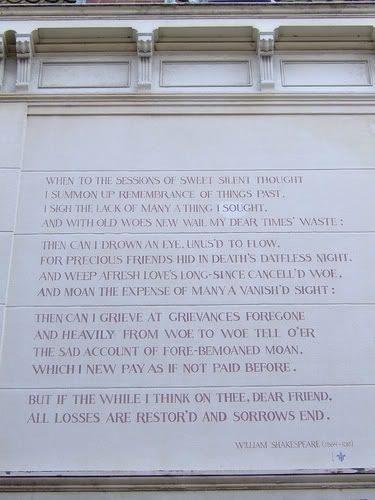
Sonnet 30
photo by Rienk Mebius.
The Renaissance was probably the most exciting and fertile period in history for a man of Shakespeare's talents to be living and working. New words were being coined every day as a result of Latin and European influences. Though he did not attend university, Shakespeare knew how to make the best possible use of all the resources at hand.
It is well known that he "borrowed" virtually all of the plots for his plays save four. This was common practice during a time in which plays were written solely for the acting company and not meant for publication. But Shakespeare's genius lies with his innovations in the dramatic potential of characterization, plot and language. The soliloquy, for example, became a way of delving deeper into the human psyche, rather than just conveying information. One could say Shakespeare took a conventional plot, and stretched it up, down, inside and out, embellishing it by entwining various sources, combining elements from world literature, picking and choosing just what he needed to create characters who would deepen our understanding of human nature.
Ultimately, it comes down to his singular use of language. There are many who say, "Shakespeare is unfathomable," or that "he is too dense and daunting," without realizing that they use some of his words and phrases all the time. Though his sonnets were written for an aristocratic audience and privately circulated before their unauthorized publication, his plays were written for a popular audience.
Unlike most theatre goers today, who may sit silently throughout a performance, Elizabethan audiences went to hear Shakespeare, and actively participated by yelling, hooting, snacking, and chatting as they followed the action. The Globe Theatre seated about 3,000 people, with "groundlings" standing right in front of the stage for a penny admission, while wealthier patrons paid more for tiered seating. Shakespeare purposely wrote for this open air, many sided, circular venue. His language was weighted with metaphor, conceit and double entendre, by turns lyrical, bawdy, colorful, grandiose. His stories appealed to the entire spectrum of London society, and he further engaged the audience via direct address and asides.

New Shakespeare Globe Theatre, Southwark (opened in 1997).
photo by wallyg.
I've been thinking about the rascals, knaves, servants and beggars who spent their pennies to hear Shakespeare. Most of them probably couldn't read, never owned any books, and were completely removed from the prevailing sonneteering vogue practiced by the aristocracy. Yet, the Bard of Avon gave them poetry! And, as poetry was born of an oral tradition, the plays nourished and enriched and entertained with stories they loved and understood -- exalted, earthy, profane and sublime. It is estimated that approximately 10% of London's population attended the theatre then, much more than in major cities today.
Well, now, no theatre experience would be complete without provisions. Street vendors of the period sold mini meat pies, apples, oranges, nuts, ale, and gingerbread, all of which were consumed as well as liberally hurled at the actors according to whim. Hazelnuts were especially popular, and were the equivalent of modern day Raisinettes. I can't imagine a more passionate crowd, littering the ground with parings and nutshells, truly believing that "the play is the thing."
Prithee, make haste and raise a tidy tankard of cider, ale, wine, or mead, in honor of Mr. Shakespeare! Neither a borrower nor a lender be; get thee some gingerbread!
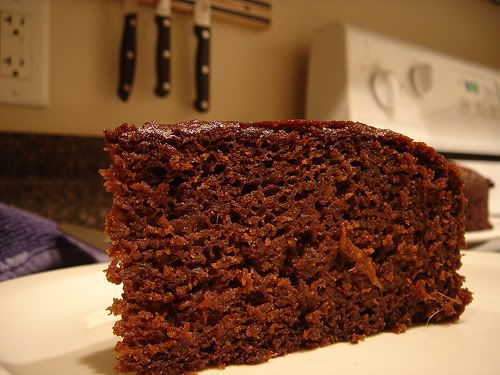
photo by allison on flickr.
William Shakespeare died of unknown causes on his 52nd birthday, April 23rd, 1616. He is buried at Holy Trinity Church, Stratford-upon-Avon. His epitaph curses any who may dare disturb his remains.
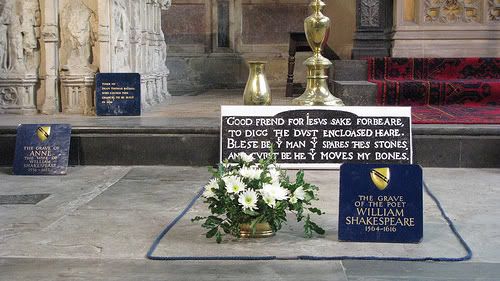
Shakespeare's tomb (photo by LuvNYankee.)
Do you know where the following phrases came from? (Answers below.)
1. Bated breath
2. Dead as a doornail
3. Neither rhyme nor reason
4. Laughing-stock
5. The green-eyed monster
6. The apple of her eye
7. Remembrance of things past
8. In my heart of hearts
9. To thine own self be true
10. Salad days.
For a list of other common words and phrases credited to Shakespeare, click here and here.
To see Shakespeare's Poesies, an A-Z listing of food references in Shakespeare's plays, click here.
Today is Talk Like Shakespeare Day!! Go here to get in on all the fun.
To see a video clip from "Shakespeare in Love," (one of my all-time fave movies), click here. *swoon*
The famous balcony scene from the Zefferelli movie can be seen here.
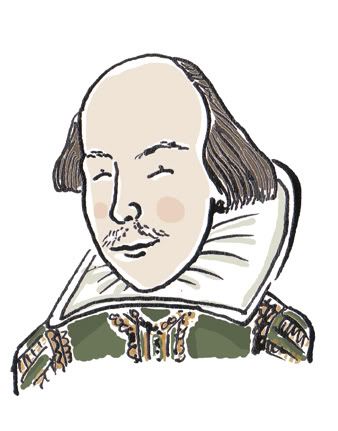
Here are the answers to the phrase quiz above:
1. Merchant of Venice
2. Henry VI, Part 2
3. Comedy of Errors
4. Merry Wives of Windsor
5. Othello
6. Love's Labour's Lost
7. Sonnet 30
8. Hamlet
9. Hamlet
10. Antony and Cleopatra.
*Shakespeare illos from emillustration's flickr photostream.
P.S. Zounds! Shakespeare did NOT invent the word, "gadzooks!"
"An I had but one penny in the world, thou shouldst have it to buy gingerbread." ~ Costard, Love's Labour's Lost.
Here's a little something to get you in the mood for Shakespeare's birthday tomorrow: a skit based on Midsummer Night's Dream. How cute is Ringo's roar?!
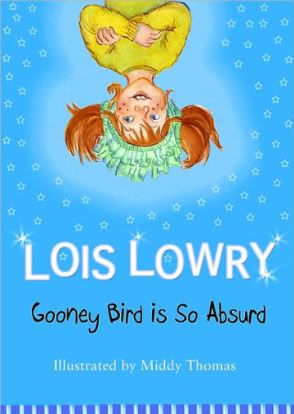
GOONEY BIRD IS SO ABSURD by Lois Lowry,
illustrated by Middy Thomas (HMH, 2009),
Chapter book for ages 6-10, 112 pp.
Gooney Bird? For National Poetry Month?
You can bet your underpants on it!
Is it true that if you warm your brain to the right temperature, you can write better poetry?
In Gooney Bird is So Absurd, the fourth book in Lois Lowry's fabulous chapter book series, the lovable, irrepressible second grader who's been captivating everyone with her brains and quirky fashion sense, proves this theory to be correct.
For the month of January, Mrs. Pidgeon is teaching her class at Watertower Elementary all about poetry. Gooney Bird gets right into the action by donning her special two-ponytail-brain-warming hat. She warns her curious, giggling classmates against calling it "underpants" to get a cheap laugh, and very wisely declares that like a poem, her green, frilly hat (perhaps underpants in another life) can be "whatever you want it to be."
With each new chapter, the class learns about a different poetic form. They begin with couplets, then move on to haiku, limericks, list poems, and poems for many voices. They even learn about the importance of constructive criticism and revision. Thanks to Mrs. Pidgeon, the humorous and endearing antics of all the kids, and Gooney Bird's ability to take charge, inspire, and spark excitement no matter what she says or does, none of it feels like "lessons." Making poems is sheer joy, and Gooney Bird and her classmates discover, among other things, that a poem doesn't have to rhyme, and "only has to be long enough to say what you want it to say."
Early on, Mrs. Pidgeon tells the class that she likes to begin each morning by reading a poem, and reveals that her mother, Mrs. X, is in a nursing home and not doing too well. While going through an old trunk, Mrs. Pidgeon finds some of her mother's poems, which she reads to her on her visits. She also shares several of these with the class, the most poignant being this list poem:
IT MAKES ME HAPPY TO REMEMBER:
A cake with pink candles,
A yellow hair ribbon,
A kitten named jingle,
The lace collar on my mother's best dress,
Ruffled curtains in my bedroom,
The fragrance of honeysuckle,
And fireflies on summer evenings,
So many fireflies.
I wonder where the fireflies have gone.
Maybe you can guess what happens next. Bad news, but Gooney Bird steps up to the plate once again, by organizing the best, most important Poem for Many Voices the class has ever done. It's beautiful how this final poem ties up all the plot points and incorporates everything the kids have learned about poetry throughout the month. Poetry is, above all, about feelings, and Gooney Bird and her classmates are full of heart and inherent wisdom.
If you're not yet familiar with the Gooney Bird series, run to the library this minute and share them with your kids. They will instantly become fascinated with the red-headed girl who showed up on her first day of school wearing pajamas and cowboy boots, and they will love Mrs. Pidgeon, who says things like, "Poetry is not to be judged. You just savor it."

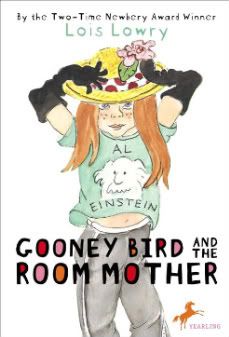
About the books, Lowry says:
Gooney Bird Greene is the child I wish I could have been, because I was a terribly shy, self-conscious child (and) I envied desperately those children who were outgoing and self-confident . . . Each book focuses on a different teaching device. In the first book, Gooney teaches the class how to tell stories, and the second one deals with words. I have in mind several other things that this unusual and very outgoing, self-confident child can give to the whole class and her teacher. These books are fun to do.
The third book, Gooney the Fabulous, is about fables, and now, Gooney Bird is So Absurd, which was released just last month, features poetry. All the characters are spot-on believable; if you love Lois Lowry already, you will love her even more (I know, how is that possible)?
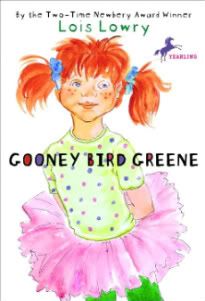
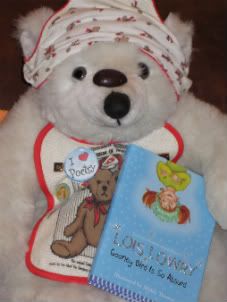
Okay, put on your brain warmer hats and get to work!
Click here to read an excerpt from Gooney Bird is So Absurd, and here for more information about the entire series.
*Snowball, pictured here with a dark chocolate raspberry egg on his nose, and teddy bear underpants on his head, would like everyone to read a Gooney Bird book to celebrate spring!

Saturday morning, Len and I headed out to Georgetown Cupcake for a little taste test. You may remember my mentioning this shop last week. It's owned by two sisters, Sophie and Katherine, who've now become quite famous all over the country for their award-winning chocolate ganache cupcakes. Research is hard work, but somebody's gotta do it.
It was a gorgeous day, and everyone was out and about, bicycling, roller blading, walking their dogs, and window shopping. We had no problem finding the shop on the corner of M and West Potomac Streets NW. Since we got there about 20 minutes after it opened, the wait line wasn't long at all.
It's such a teeny tiny place; it's hard to imagine they sell between three to five thousand cupcakes a day, at $2.75 a pop. I was surprised at how many people kept streaming out of the shop with goodies (and smiling, of course). When I finally made it to the top step, I saw this:


Yum! Flood of excitement and happiness. Cupcakes = childhood, celebrations, good times. A friendly college student took my order, while two others carefully packed my cupcakes in lovely pink boxes -- one for us, and one for Len's cousin, Liz, who lives in Georgetown. It was her birthday, so we thought we'd surprise her with some cupcakes. What? No, we weren't using Liz as an excuse for buying cupcakes. You think? No, couldn't be. What guilt?

Turns out, though Liz has lived in Georgetown forever, she didn't know about Georgetown Cupcake. But she squealed with delight at her box: red velvet, chocolate ganache, lemon berry, cherry blossom, and vanilla.

Len got quite possessive with the other box -- almost the same selection as Liz, but with mocha and coconut. (Len is fanatical about all things coconut.)

So Liz put on the tea kettle, while we sat at her dining table, with fresh, spring air wafting in through the open windows. We chatted about "John Adams," little birthdays, and preserving her mother's handwritten recipes. Oh, and we tested our little cupcakes!
Observations:
Overall, the cupcakes were smaller than I expected, and had too much frosting.
But having said that,
Len's coconut cupcake was supremely wonderful -- the cake was very moist and the frosting was pudding-ish with coconut flakes that weren't overly sweet.

Cherry blossom was my favorite cake -- a slightly chewy texture because of the added cherry pieces, and delightful layers of flavor that really made me sit up and take notice.
Lemon berry was "interesting," as Liz and I agreed. It was a surprise to taste tangy lemon in a fuschia-colored frosting.
Red velvet was just okay.
And the much-touted chocolate ganache? The cake by itself was nothing exceptional. The ganache frosting was superb, and is really what "makes" this cupcake. But -- it reminded me of my own chocolate midnight cake, which has a vanilla pudding filling, and a cooked chocolate frosting.

My conclusion: it's loads of fun to taste gourmet cupcakes, but there's still nothing like a fresh, homemade cake, lovingly baked from scratch, especially from a recipe that's been handed down via family or friends. I prefer my aunt's red velvet cake to GC's red velvet cupcakes, but I am curious to see how those chocolate ganache cupcakes would turn out if I made them myself (recipe is here).
Hmmm -- on second thought, I can't really stop here. Far more research seems warranted. There's Swirls in Beverly Hills, and Atlanta Cupcake and Kara's in San Francisco . . . because you just can't top the look on someone's face when you show up at their door, and announce, "We've got cupcakes!"
To see a video of Georgetown Cupcake, click here.
And Sophie and Katherine are now selling a sterling silver bracelet with cupcake charms of some of their popular flavors. Yes, I want!
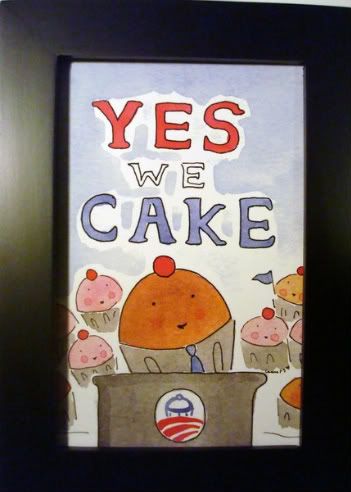
Available as a 4" x 6" framed print here.
So, if you read my "Crazy for Cupcakes" post yesterday, you may have noticed a couple of adorable ink and watercolor images featuring some very fetching cupcakes.
They were created by Seattle artist, Jessie Oleson, who is the mastermind behind one of my fave food blogs, Cakespy.com. Have you been? Cakespy is dedicated to "seeking sweetness in everyday life," and is just the thing to satisfy your cravings for cake, cake, and more cake, and any and all forms of delectable dessert. Regular features include, "Batter Chatter," (interviews with seriously great bakers from around the country), "Cakewalk," (bakery travel guides), and "Behind the Sweetness" (stories and lore behind popular baked goods).
Jessie, who is a self-avowed "cake sleuth," really dives into the layers of the who, what, why, where, and how of cakes. Her posts are often beautiful, sometimes quirky and surprising, always delightful and brilliant.
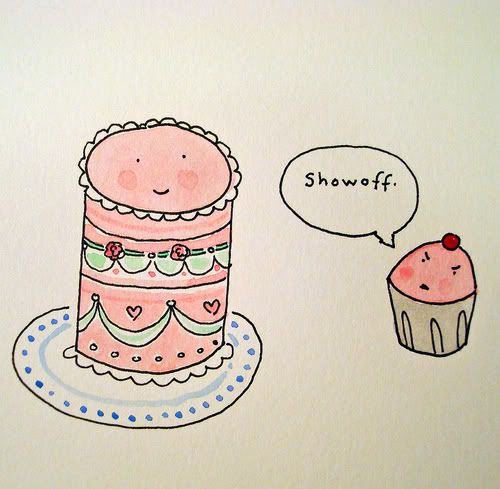
"Cuppie," Cakespy's official mascot and subject of hundreds of charming ink and watercolor paintings (some of which can be purchased at her Etsy Shop), is the haute cupcake of all time. According to Jessie, Cuppie was made from some left over cake batter, and has always had a chip on his shoulder for not being a whole, complete cake, so he's gotten into a lot of adventures and misadaventures.
Here are some Cuppies at the library,
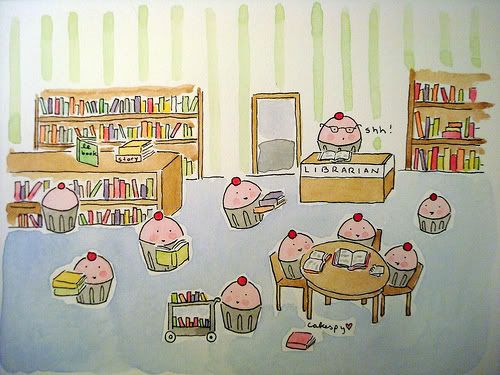
a swim meet,
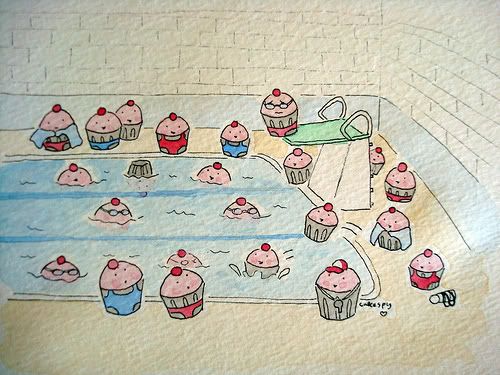
charming a gnome (this one's for you, Kelly),
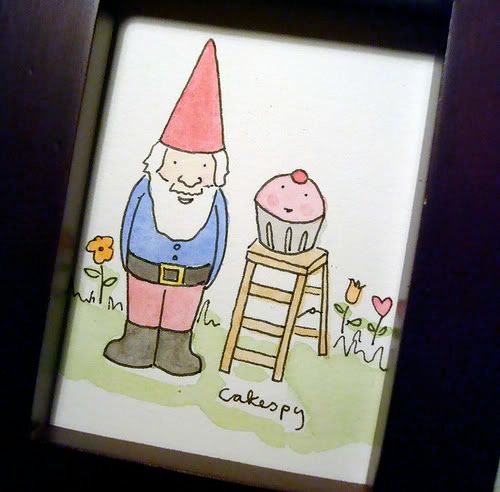
and diving into the middle of the action.
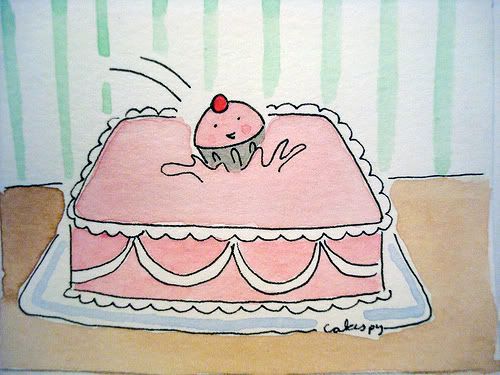
I just ordered this bookmark* (see below for book titles),
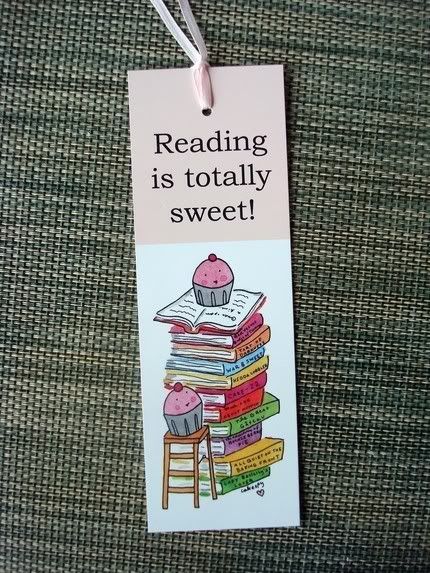
and this box of 10 assorted Cakespy notecards!
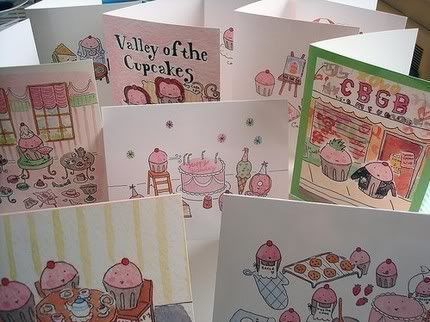
And, I absolutely must mention this crazy cool, absolutely brilliant post from Cakespy, "Like a Rolling Stone: A Collection of Rock n Roll Inspired Sweets." OMG!! I so totally LOVE these creations. I don't want to spoil any of your fun, but can I just say, "James Brownie," and "Crosby, Stills, Ganache and YUM?" Who knew that Keith Richards looked like a scone? Okay, I will say no more. Just go, and enjoy!!
MORE CUPPIE CUTENESS:
You also MUST see Jessie's "Fine Art Series" on flickr.com.
Lots more original work here, and her Etsy Shop is here.
For a short video interview with Jessie Oleson, click here.
*Titles on "Reading is Sweet" bookmark:
Red Velvet Badge of Courage
Tart of Darkness
War & Sweet
Hedda Cobbler
Cake-22
Much Ado About Muffin
The Great Gateau
The Adventures of Huckleberry Pie
All Quiet on the Baking Front
Lady Batterly's Lover.



Have a cupcakery day, and embrace the sweetness!
**All images, with the exception of the bookmark and notecards, are from Jessie's Cakespy flickr photostream.
"Life is uncertain. Eat dessert first." ~ Buttercup Bake Shop

If you think you've been seeing cupcakes everywhere, you're definitely not imagining things. Ever since Carrie and Miranda ate those famous Magnolia Bakery cupcakes on "Sex and the City" back in 2000, everyone has gone cupcake crazy.
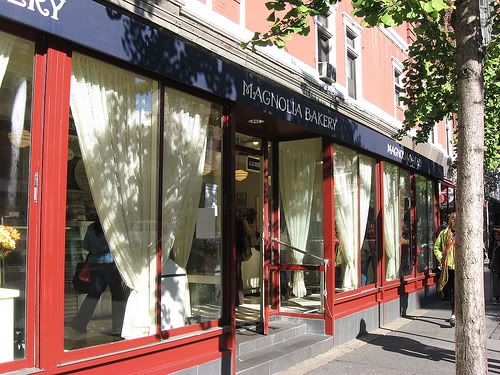
photo by yummyinthetummyblog.
Actually, Magnolia Bakery cupcakes had been oh-so-cool as far back as 1996, when co-owners Jennifer Appel and Allysa Torey began to specialize in cupcakes after they made a batch from leftover cake batter and noticed how quickly they were snatched up. "Sex and the City" then turned the Greenwich Village bakery into a tourist shrine, and cupcake specialty shops have been sprouting up across the country ever since.
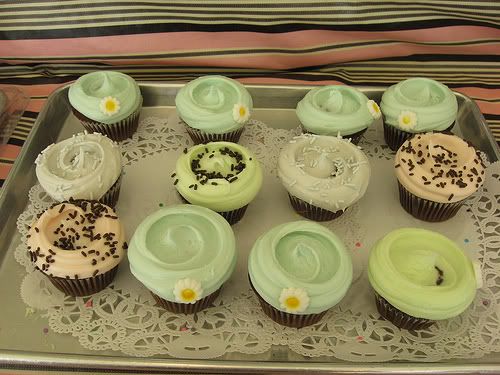
Magnolia Bakery delectables (yummyinthetummy).
Today's gourmet cupcake is a far crumb from the ones we ate in childhood. They've gone deliciously upscale, made of the finest, freshest ingredients, like Valrhona chocolate, Madagascar Bourbon Vanilla, and European sweet cream. Flavors like lava fudge, ginger lemon, passion fruit poppy seed, and chai latte beg for your attention alongside the traditional vanilla and chocolate. Some are filled with luscious, flavored creams, others adorned with coconut or colorful sprinkles. What do you say to a chocolate liquer cupcake filled with raspberry Chambord cream, topped with white chocolate meringue frosting?
Oo-lah-lah. I'd love to peel off your paper.
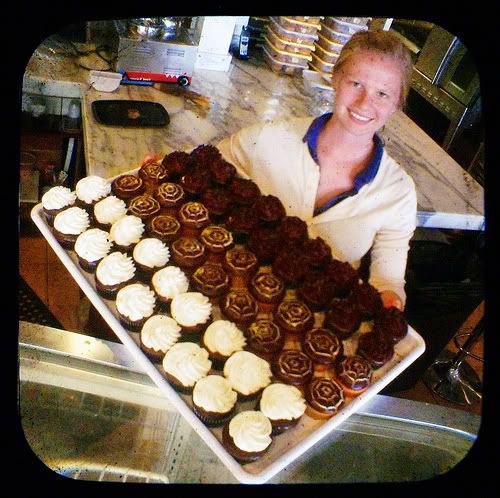
Molly's Cupcakes in Chicago offers Cookies 'n Cream, Boston Cream Pie,
and Chocolate Decadence (photo by FriendlyJoe).
So, why are seemingly sensible, professional, sophisticated adults willing to stand in long lines at any time of the day for a cupcake fix? It's mostly about nostalgia. We want a reminder of safer, happier, simpler days -- school birthday parties, picnics, church bake sales, cupcakes specially decorated for Halloween, Easter, or St. Patrick's Day. One of my happiest grade school memories is when my mom was Room Mother, and she ordered cupcakes for our class. No matter that they came from a bakery and that she never baked cupcakes herself -- those cupcakes symbolized everything that was right in my world.
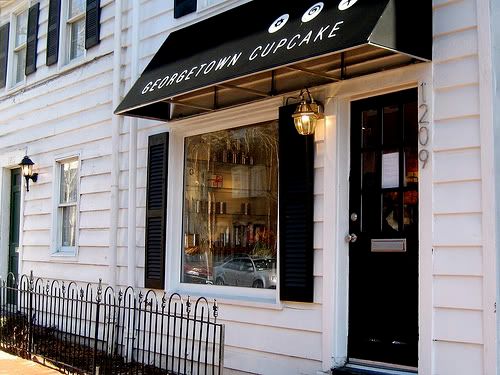
photo of Georgetown Cupcake in Washington,D.C., by M.V.Jantzen
And who can resist them? They're small, cute, perfect, and portable. You get one all to yourself. There are no quibbles about somebody else getting a bigger piece of cake, and there's far less guilt over eating just one little cupcake. They can be decorated in an infinite number of ways to suit any occasion, all celebrations. Bakers, amateur or professional, can go wild experimenting with new flavor combinations. Even in these tough economic times, people are willing to shell out $2 to $4 for a little taste of heaven.
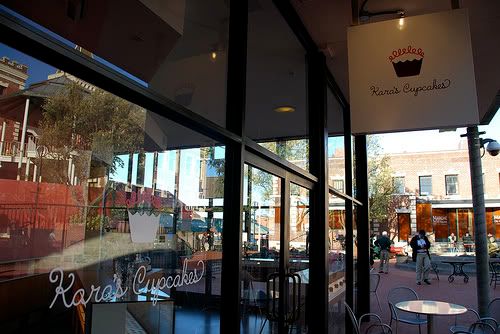
Kara's Cupcakes, Ghirardelli Square, San Francisco
(photo by Steve Rhodes).
Have you ever wondered how cupcakes got their name?
Two theories, both supported by historic evidence, have emerged. First, that in the early 19th century, there was a shift from measuring ingredients by weight to measuring by cups to save time in the kitchen. Cupcakes were sometimes called "number" cakes in those early days, because numbered ingredients made the recipe easy to remember: one cup of butter, two cups of sugar, three cups of flour, etc.
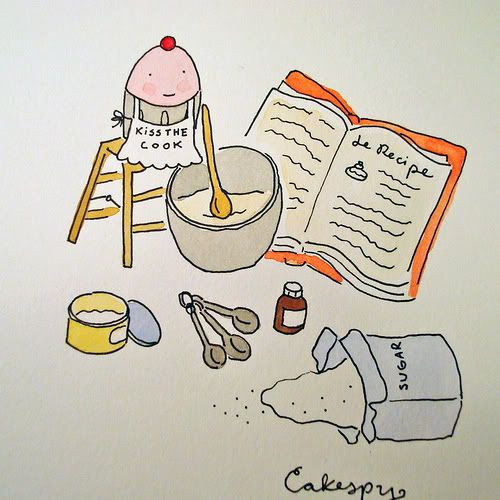
"Cupcake Makes a Cake!" by cakespy.
The second theory harkens back to small cakes actually baked in earthenware teacups or small clay baking pans, so they would bake faster in hearth ovens. Individual cakes date back to the 18th century; a good example is the Queen's Cake from England, a rich, creamy blend containing currants, lemon zest, and chopped almonds.
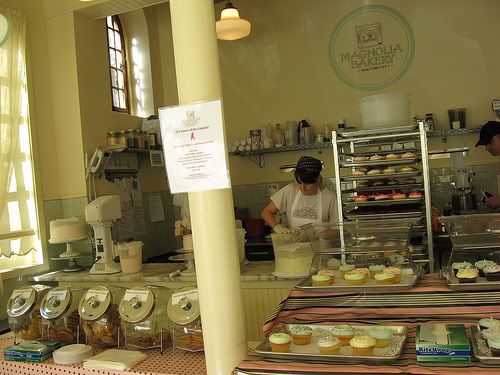
Magnolia Bakery interior (photo by yummyinthetummy).
Cupcake mania shows no signs of slowing down, either. While other businesses have been struggling, cupcake shops seem to bustle with business, providing a happy, charming, homey atmosphere, where eager customers walk in smiling, in anticipation of that first bite. And the internet has become that much sweeter with the proliferation of blogs devoted solely to everything cupcake. They feature recipes, taste tests, news about store openings, cookbooks and related merchandise, and offer a forum for cupcake aficionados all over the world to gather and simply talk cupcake.
According to Publisher's Weekly, cupcake mania has translated into ever-emerging batches of cookbooks that seem to fly off the shelves before they've had time to cool. Sellers do not feel the market is yet saturated; in some cases, the mere image of cupcakes on a cover has attracted buyers, even though the book's focus is not on cupcakes.
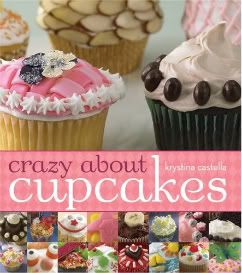
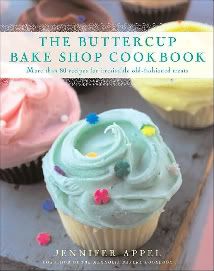
Like apple pie and hotdogs, cupcakes are classic Americana, a beloved comfort food. And we all know you shouldn't mess with that. Back in December 2006, a federally-mandated healthy foods plan was enacted in school cafeterias across the country in an attempt to curb childhood obesity. But when the principal at George Mason Elementary here in Virginia tried to ban cupcakes for classroom birthday parties, parents (moreso than kids) were outraged. Cupcakes symbolized the very essence of childhood innocence, and were a traditional and economic way to celebrate. Needless to say, the ban was half-baked and cupcakes gained even greater respect.
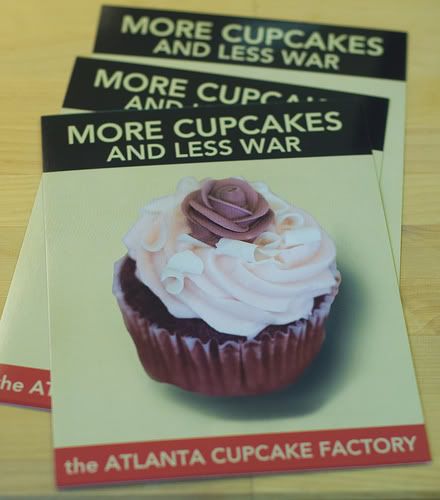
photo by Brian Wible (Stacie Joy for CTTC's photostream).
These days, Jennifer Appel, who claims to have ignited the current cupcake craze, is no longer affiliated with Magnolia Bakery. In 1999, she split from her partner and opened the Buttercup Bake Shop in midtown Manhattan. Her old fashioned American desserts have been such a hit, that she opened a second shop in the Upper West Side, and is now selling franchises across the country. Cupcakes may be small, but somehow they have a magical way of multiplying.

Exterior of Buttercup Bake Shop by M.V.Jantzen

Some of Buttercup's gourmet offerings (photo by robobby).
I can see that a "research" trip to Georgetown Cupcake is in order. Their Chocolate Ganache recently won the Washington Post Cupcake Wars, and has been rapturously described in magazines and on TV. I'll let you know, so stay tuned.
Meanwhile, I'm curious. What's your favorite cupcake? And how do you eat them -- lick off frosting first, just bite in, nibble around the edges?
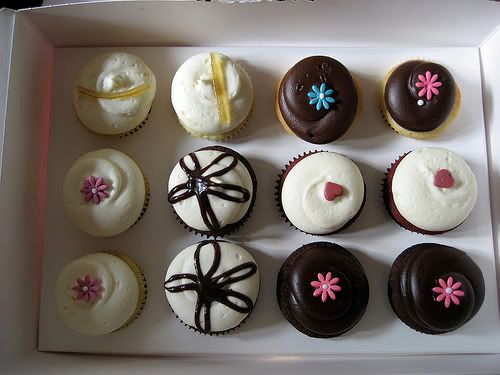
from Georgetown Cupcake (photo by BrassPotato).
ICING ON THE CAKE:
For a list of great cupcake blogs, including Cupcakes Take the Cake, Cakespy, and 52 Cupcakes, click here.
For National Geographic's list of "25 Cupcakeries We Love," click here. (Have any of you been to any one of these?)
Visit MarthaStewart.com for recipes and videos of Cupcake Week.
Don't miss Sweet Cuppin Cakes Bakery and Cupcakery Supplies. Love their designer baking cups.
Adorable cupcake apron at Carolyn's Kitchen!
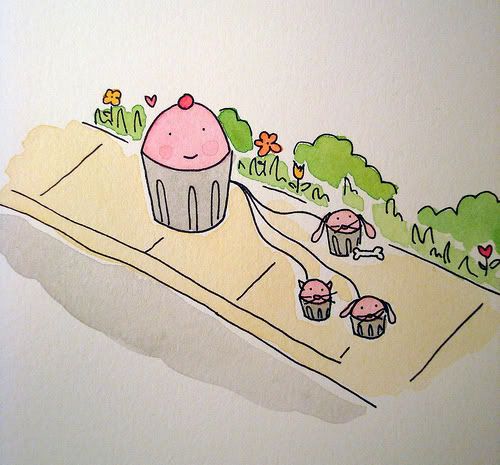
"Cupcake Walks Pets" by cakespy.
*Cupcakes at the beginning of this post by gemini angel art.
"Pure bliss baked daily. Happiness in the palm of your hand. Joy never tasted so good." ~ Georgetown Cupcake
Warning: The following post contains photos of unbearably adorable rabbits capable of blatant emotional manipulation.
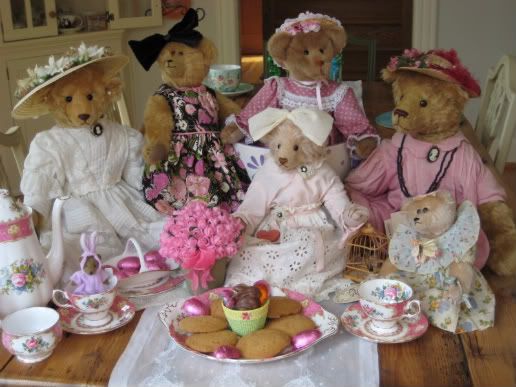
Emma, Madeline, Nancy Jane, Nettie, Eloise, and Sylvia don their bonnets and bows for Easter tea.
Well, it's happening again.
My ears are growing, and my nose is twitching. That can only mean one thing.
It's carrot time!

photo mosaic from mkasahara's photostream
Wait a minute. Wait a minute! Don't you mean rabbit time?
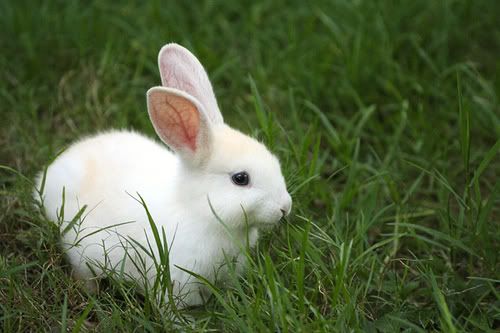
photo by S. Das
Time for all of us soft, cute, furry bunnies to melt hearts everywhere?
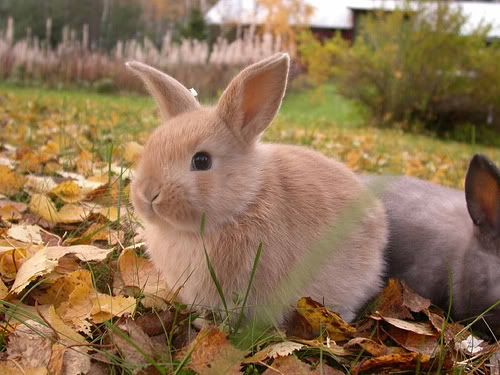
photo by Madeleine
I don't know about you, but here in New Hampshire it's not even spring yet.
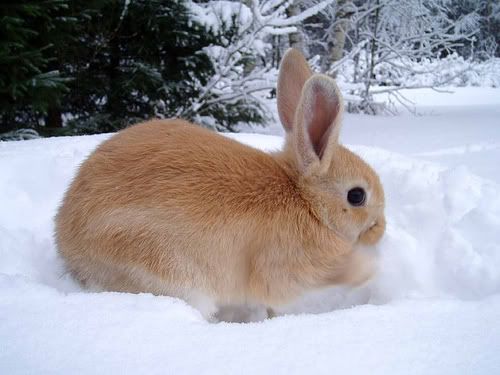
photo by Madeleine
Carrots? Did someone say carrots?
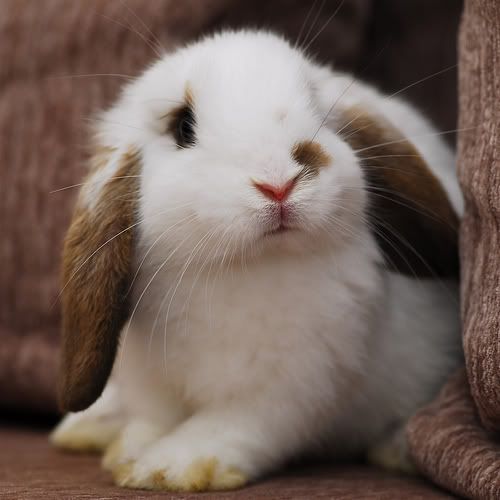
photo by faisalee
Bleckk! I'd rather have cake.
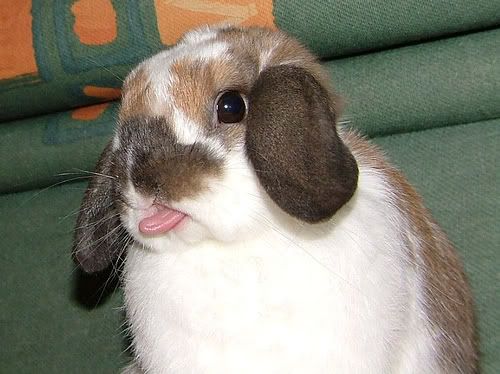
photo by jpockele
Here's one with marzipan veggies and everything.
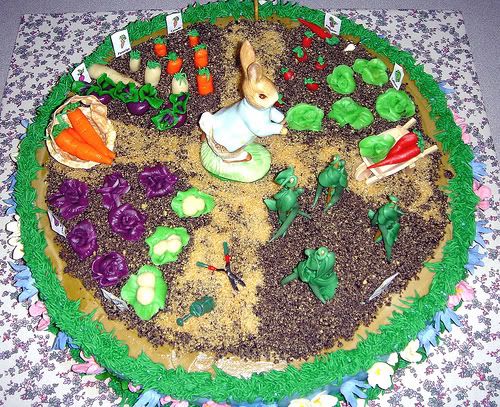
photo by Cake Doctor
Oh, this one looks nice.
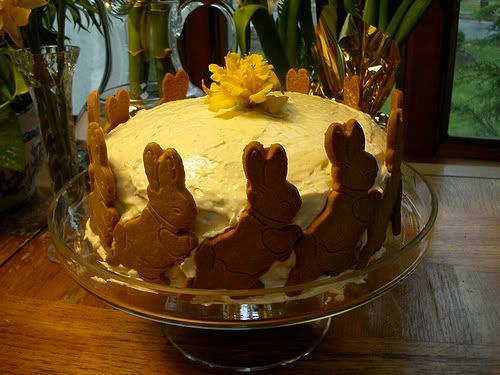
photo by atnaturesmercy
I know! Let's make our own Easter cake. Miss Potter will help us.
First, we'll go to her garden:
WE HAVE A LITTLE GARDEN

Garden at Beatrix Potter's Hill Top Farm, Near Sawrey, England
photo by gobucks2
We have a little garden,
A garden of our own,
And every day we water there
The seeds that we have sown.
We love our little garden,
And tend it with such care,
You will not find a faded leaf
Or blighted blossom there.
I'm sure carrots are growing there. Oh, who's that?
THE LITTLE BLACK RABBIT
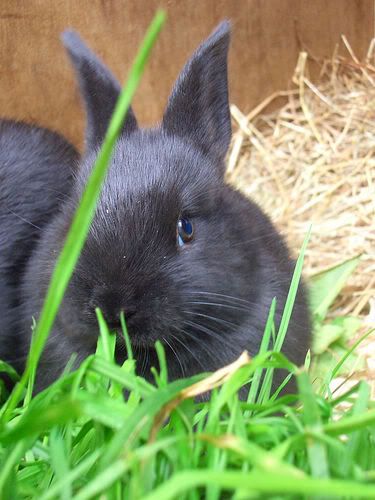
photo by Martin Sweeney
Now who is this knocking
at Cottontail's door?
Tap tappit! Tap tappit!
She's heard it before?
And when she peeps out
there is nobody there,
but a present of carrots
put down on the stair.
Hark! I hear it again!
Tap, tap, tappit! Tap
tappit!
Why -- I really believe it's a
little black rabbit!
Be a bunny this year, and bake a cake for those you love. Here's my favorite Easter cake recipe. We like to serve ours on Peter Rabbit plates, and don't mind getting frosting on our whiskers!
14 CARROT CAKE
(serves a bunch of bunnies)
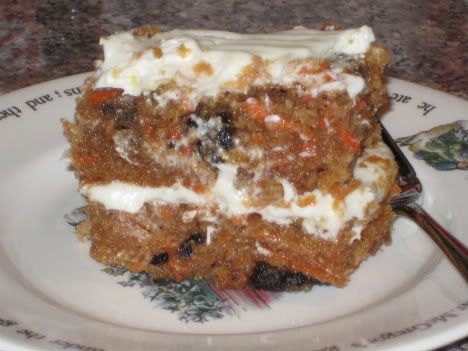
Beat together:
2 cups sugar
1-1/2 cups oil
4 eggs
1 tsp. vanilla
Sift together:
2 cups flour
1-2 tsp. cinnamon
1 tsp. salt
2 tsp. baking powder
1-1/2 tsp. baking soda
Combine egg mixture with flour mixture.
Then, combine:
2 cups grated carrots
1 (8-1/2 oz.) can drained pineapple
1/2 cup chopped walnuts
Add this to the batter.
Place a paper towel on the bottom of a 9" x 13" pan.
Add batter, then bake at 350 degrees for 45-50 minutes. Cook until slightly pulled away from the pan. Cool completely before frosting.
CREAM CHEESE FROSTING
1 1b. powdered sugar
8 T soft butter
8 oz. cream cheese
1 tsp. vanilla
1/2 cup chopped walnuts
*Alternately, you can bake this in two 8 or 9" round cake pans.
NOTES:
This cake is almost foolproof, unless you overbake it. Otherwise, it's moist, moist, moist.
It's so delicious that hundreds of rabbits (or people dressed as rabbits), may follow you everywhere, twitching their noses and begging for more.

Have a Hippity Hoppity Easter! I'll see you next week!
To read my post, "Tea with Miss Potter," click here.
*Poems are from Beatrix Potter's Nursery Rhyme Book (F. Warne & Co., 1984).
"All good poetry is the spontaneous overflow of powerful feelings." ~ Wordsworth, Preface to the Lyrical Ballads, 1802.
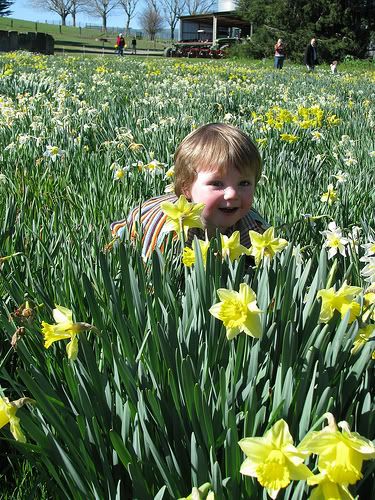
photo by heart felt
I've been seeing daffodils everywhere, so it truly must be Spring.
Though crocuses are usually the first to pop up at winter's end, it's those showy yellow daffodils, bobbing their heads in the breeze and trumpeting Spring's arrival, that makes it official.
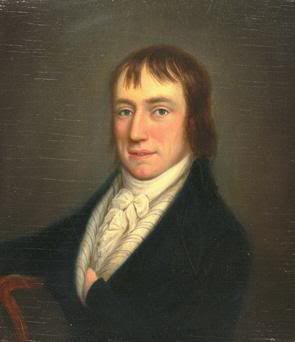
Wordsworth portrait by William Shuter, 1798
It just so happens that the man who wrote the most famous daffodil poem ever, William Wordsworth, is celebrating his 239th birthday today. You probably know him as the preeminent poet of England's Lake District, who, along with Samuel Taylor Coleridge, pretty much ignited the Romantic movement.
April must have been a good month for poems even back in the 19th century, because it was on April 15, 1802, that Wordsworth and his sister, Dorothy, visited a friend in Eusmere, and on their walk home to Grasmere, saw "a host of golden daffodils" along the shore of Ullswater.

Ullswater is the second largest lake in the Lake District, considered by many
to be the most beautiful.
Dorothy recorded the experience in her diary, and it is widely believed this formed the basis for Wordsworth's most well known poem, "I Wandered Lonely as a Cloud," which he wrote two years later at Dove Cottage.
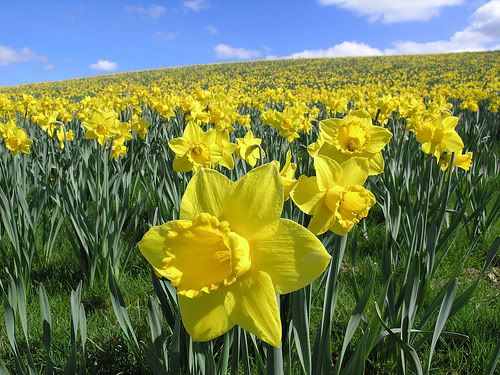
photo by Garry Platt
I first read the poem in high school, then studied Wordsworth in greater depth in college. Yes, I had read the requisite Chaucer, Milton, Shakespeare, Pope and Spenser, like any conscientious English major. But it wasn't until my class in the Romantics that I became wholly enamored with poetry.
Finally -- poetry that emphasized and valued the inner emotions of the poet, with diction that resembled natural speech! Poetry that focused on "incidents and situations from common life," that was colored by the imagination, "whereby ordinary things should be presented to the mind in an unusual way."
Yes! Enough of elevated language that placed the reader at a distance. Enough of archaic forms and structures that excluded readers rather than engaged them! Wordsworth's intent in writing poetry that spoke to the common man in his own language, a poetry of sincerity and passion rather than stilted artifice (as outlined in his Preface to the Lyrical Ballads), was, in some ways, a reaction against the adverse effects of urbanization, industrialization, mass media, and mass culture:
He attributed to imaginative literature the primary role in keeping the human beings who live in such societies emotionally alive and morally sensitive. Literature, that is, could keep humans essentially human. (Norton Anthology of English Literature, Vol. 2, Eighth Edition).
And in order to do this, poetry must be, above all things, accessible.

Another view of Ullswater.
"I Wandered Lonely as a Cloud" is much more than an iconic poem everybody knows or memorizes. In a small space of four stanzas, it encapsulates the essential elements of Wordsworth's new and experimental Romantic theory: simple language, a rustic setting, focus on the poet's emotional reaction to nature, the crucial role of the imagination in spawning "emotion recollected in tranquility," thereby validating the inherent power and resonance of instinctual, elemental sensibilities.
The fact that this poem is now largely part of our DNA, whether we claim to be poetry lovers or not, proves Wordsworth correct. The purest, truest human feelings have the best chance of being accurately conveyed in a language utilized by the common man.
While living in England years ago, I finally got to visit the Lake District for myself. It was definitely one of those "dreams-come-true" experiences. We saw Beatrix Potter's Hill Top Farm in Near Sawrey, and the spectacular ruins of Tintern Abbey. And then -- there was Dove Cottage itself, originally an inn called the Dove and Olive, preserved just as it was when Wordsworth, Dorothy, and his wife, Mary, lived there between 1799-1808.

Dove Cottage (photo by Paul Tuna Turner)
As I stood on those flagstone floors and gazed at the dark paneling and white washed walls, I thought how miraculous it was, that a girl from Hawai'i who so loved this poet and once marked her textbooks with extensive marginalia and memorized countless lines, should now be there in the very house where he wrote his greatest poems, where his sister wrote her journals, where Coleridge and other leading figures of the day frequented almost 200 years before.
This experience alone made my long journey to England worth it. Book study is one thing, being there in person quite another. When I saw how the light filtered through the windows, how the air felt and smelled -- the poems I knew only from books finally came alive. The imagination that Wordsworth had time and again touted as man's supreme gift, has ever since enabled me to see, understand, and endure.
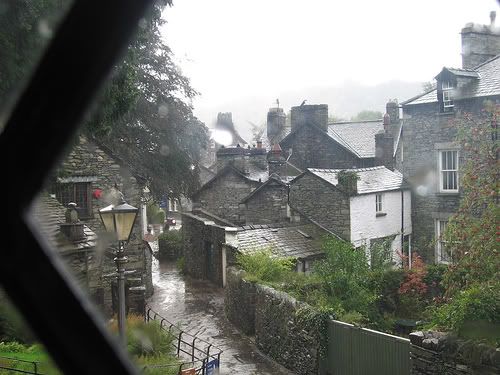
View from Dove Cottage (photo by Ichabod2)
Though today we might take for granted the value and privilege of individual creativity and innovative freedom, it is worth remembering those who challenged existing doctrines and through their innovations revolutionalized the poetical landscape. I am reminded of this every spring with the daffodils. How about you?
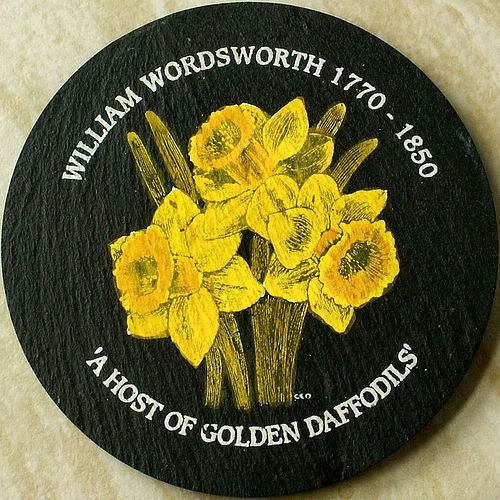
photo by Ennor
I WANDERED LONELY AS A CLOUD
by William Wordsworth
I wandered lonely as a cloud
That floats on high o'er vales and hills,
When all at once I saw a crowd,
A host, of golden daffodils;
Beside the lake, beneath the trees,
Fluttering and dancing in the breeze.
Continuous as the stars that shine
And twinkle on the milky way,
They stretched in never-ending line
Along the margin of a bay:
Ten thousand saw I at a glance,
Tossing their heads in sprightly dance.
The waves beside them danced; but they
Out-did the sparkling waves in glee:
A poet could not but be gay,
In such a jocund company:
I gazed - and gazed- but little thought
What wealth the show to me had brought:
For oft, when on my couch I lie
In vacant or in pensive mood,
They flash upon that inward eye
Which is the bliss of solitude;
And then my heart with pleasure fills,
And dances with the daffodils.
Happy Birthday, Mr. Wordsworth!
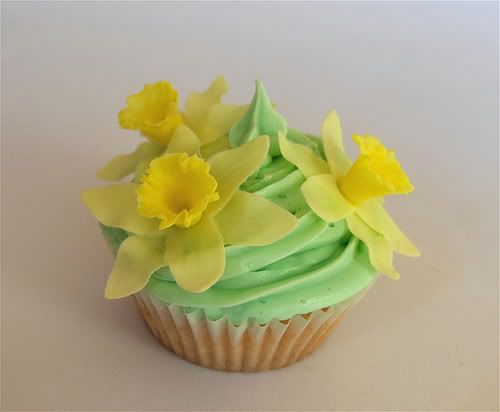
photo by abbietabbie
To read Dorothy's journal entry and hear a reading of the poem, click here.
Kelly Fineman has written numerous posts about Wordsworth. Read her excellent explication of "I Wandered Lonely as a Cloud," here, and her ruminations on "Ode: Intimations of Immortality From Recollections of Early Childhood," probably my favorite Wordsworth poem, here.
The Dove Cottage, Wordsworth Museum and Art Gallery has more interesting info on their website.
"Fill your paper with the breathings of your heart." ~ Wordsworth
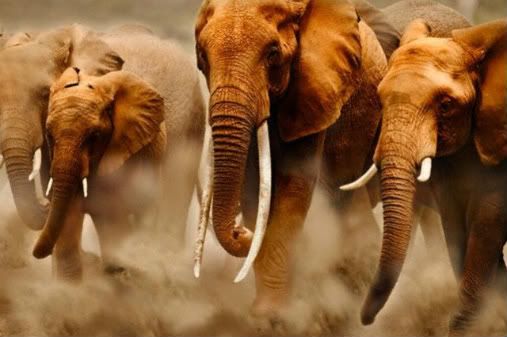
Look out! Take cover! Clear the decks!
A stampede is coming!!
Just two days from now, Monday, April 6th, to be exact, Stampede!: Poems to Celebrate the Wild Side of School, by the amazingly prolific author and poet, Laura Purdie Salas, will be officially released through Clarion Books! WooHoo!!
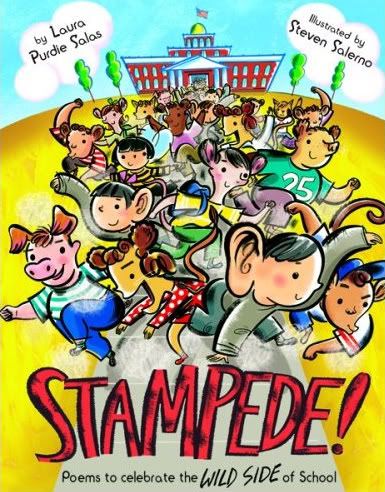
STAMPEDE!: POEMS TO CELEBRATE THE WILD SIDE OF SCHOOL
by Laura Purdie Salas, pictures by Steven Salerno,
(Clarion Books, 2009), Ages 4-8, 32 pp.
That's right. One of Poetry Friday's regular participants, deemed last year an official Poetry Princess, she of the famous 15 Words or Less weekly poetry writing feature, is launching her first trade book collection of poems for kids.
Friends, I gotta tell you, this book is deliciously wild. I received a review copy from the fabulous folks at Clarion, and I've been gleefully eating up all of Laura's poems and Steven Salerno's wacky and imaginative brush, gouache, and digitally enhanced illustrations.

Resident animals enthusiastically welcome Laura's new book.
Laura's theme is exceedingly clever. She says she got the idea from her daughter, Maddie, who had to have two teeth pulled when she was in the third grade. Laura took Maddie out for a milkshake, and Maddie replaced her missing teeth with straws. A walrus! A few months later, Laura visited Maddie's class and they all wrote poems comparing themselves to animals. From then on, a veritable stampede of kids-as-animals poems thundered through Laura's brain, and some of them became this book.
From the opening poem, "Swarm," where kids flood the schoolyard, buzzing and flitter-tumbling, to the jubilant "Stampede" of elephants at day's and book's end, readers (young and old), will be able to identify with the all-too-familiar scenarios.

Winkler ogles "Here Boy," a poem about lunch.
Remember how your stomach growled like a starving bear during class? Or how big and scary a new school felt on the first day, making you feel like a mouse in a maze? Or how you wanted to retract into your turtle shell so the teacher wouldn't call on you? Laura really nails the universal emotions of the school experience in all its joy and angst. Kids (while laughing) will be reassured that they're not the only ones, and adults will be reminded that what we sometimes consider to be minor or trivial things, can be a big deal to a child.
Go on, sample these tasty poems paired with their spreads:
"Ducks in a Row"
Do you all
Understand how we walk while in school?
Children, listen!
Keep quiet's the number one rule.
Leave the lockers alone and
I'm sure you'll do fine.
No poking or
Giggling -- and
Stay in your line!
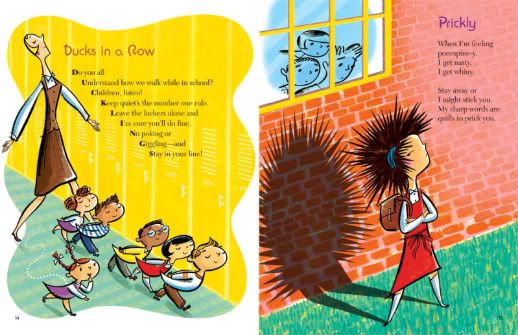
"Prickly"
When I'm feeling
porcupine-y.
I get nasty,
I get whiny.
Stay away or
I might stick you.
My sharp words are
quills to prick you.

"Stampede"
The last bell rings
We spill outside,
like captives finally freed.
We're thundering, fumbling
elephants --
an after-school stampede.
Now, please join me in my favorite alphabet soup tradition, of celebrating new book releases with a special bowl of soup. Let's all congratulate Laura with a virtual stampede of buzzes, oinks, trumpets, eeks, grunts, growls, quacks, barks, tweets, rumbles and roars. Then, spend the rest of the day looking at your co-workers, family members or even strangers on the street. What kind of animals are they? What about you?

Today's Lunchbox Special: Salas Super Stampede Soup (guaranteed to make you earn better grades in school).
What? You thought I forgot dessert? It's Poetry Month, so you can have your cupcake and eat it too:
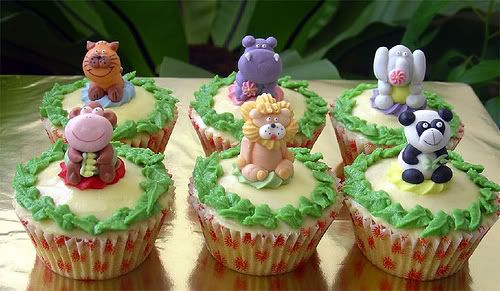
Which animal are you? (photo by specialcakes/tracey)
 Be sure to join Laura for her online Stampede Launch Party, all day Monday. There'll be videos, readings, poems that didn't make the cut, and much more. (I'm already wearing my elephant ears and nose, and can't wait to party down!)
Be sure to join Laura for her online Stampede Launch Party, all day Monday. There'll be videos, readings, poems that didn't make the cut, and much more. (I'm already wearing my elephant ears and nose, and can't wait to party down!)
 Click here for the special Stampede! web page. View the book trailer here, and knock yourself out with a fun activity sheet on writing animal poems here.
Click here for the special Stampede! web page. View the book trailer here, and knock yourself out with a fun activity sheet on writing animal poems here.
 Visit Laura's official website for information about her other books (she's also published tons of nonfiction titles and 10 poetry collections for the educational market)! It's full of great resources for writers and poets, and details her presentations, school visits, and online classes.
Visit Laura's official website for information about her other books (she's also published tons of nonfiction titles and 10 poetry collections for the educational market)! It's full of great resources for writers and poets, and details her presentations, school visits, and online classes.
 Of course, don't miss her Live Journal blog, Writing the World for Kids, for the latest updates. For those especially interested in book promotion, also check out Bubble Stampede, where Laura co-blogs with Fiona Bayrock every Monday. For the past 9 months or so, these two ladies have been filling us in on all the nuts and bolts of launching and promoting their first children's trade books.
Of course, don't miss her Live Journal blog, Writing the World for Kids, for the latest updates. For those especially interested in book promotion, also check out Bubble Stampede, where Laura co-blogs with Fiona Bayrock every Monday. For the past 9 months or so, these two ladies have been filling us in on all the nuts and bolts of launching and promoting their first children's trade books.
 Amy Planchak Graves is hosting the Poetry Friday Roundup today. Be sure to check out all the other reviews and poems being served, and have a good weekend!
Amy Planchak Graves is hosting the Poetry Friday Roundup today. Be sure to check out all the other reviews and poems being served, and have a good weekend!
 To see all the Soup of the Day Book Release posts on this blog, click here.
To see all the Soup of the Day Book Release posts on this blog, click here.
**And don't forget, starting Monday, you can thunder over to your local indie or click through to your fave online bookseller, to capture your copy of Stampede!
*Interior spreads from Stampede! posted by permission of the publisher, text copyright © 2009 Laura Purdie Salas, illustrations copyright © 2009 Steven Salerno; Clarion Books, an imprint of Houghton Mifflin Harcourt. All rights reserved.















































































































 Be sure to join Laura for her
Be sure to join Laura for her